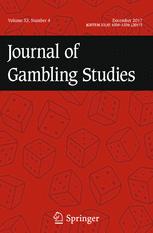 Título: Social cost of pathological gambling
Título: Social cost of pathological gambling
Autores: Robert Ladouceur Ph.D., Jean -Marie Boisvert, Michel Pépin, Michel Loranger, Caroline Sylvain
Data: 1994
Abstract
Pathological gambling creates enormous problems for the afflicted individuals, their families, employers, and society, and has numerous disastrous financial consequences. The present study evaluates the financial burdens of pathological gambling by questioning pathological gamblers in treatment in Gamblers Anonymous (n=60; 56 males, 4 females; mean age = 40 years old) about personal debts, loss of productivity at work, illegal activities, medical costs and the presence of other dependencies. Results show that important debts, loss of productivity at work and legal problems are associated with pathological gambling. Discussion is formulated in terms of the social cost of adopting a liberal attitude toward the legalization of various gambling activities.
References
-
Abt, V., Smith, J.F., & Christiansen, E.M. (1985).The business of risk: Commercial gambling in mainstream America. Lawrence, Kansas: University of Kansas Press.Google Scholar
-
Christiansen, E.M. (1993). Income 1992 gross annual wager of the U.S. Part 1: Handle.Gaming and Wagering Business, 14, no 7, 12–35.Google Scholar
-
Custer, R.L., & Milt, H. (1985).When luck runs out. New York: Facts on File Publications.Google Scholar
-
Eadington, W.R. (1989). Problem gambling and public policy: Alternatives in dealing with problem gamblers and commercial gambling. In H.J. Shaffer, S.A. Stein, B. Gambino, & T.N. Cummings. (Eds.),Compulsive gambling: Theory, research, and practice. Lexington, MA: Lexington Books.Google Scholar
-
Gaboury, A. & Ladouceur, R. (1993). Evaluation of a prevention program for pathological gambling among adolescents.Journal of Primary Prevention, 14, 21–28.Google Scholar
-
Gambino, B., Shaffer, H.J., & Cummings, T.N. (1992, November, December). Compulsive Gambling: An Overlooked Problem.EAP Digest, pp. 32–35, 46–47.Google Scholar
-
Harris, J.L. (1988). A model for treating compulsive gamblings through cognitive-behavioral approaches.Psychotherapy and the Self-Contained Patient, 4, 211–226.Google Scholar
-
Kallick, M., Suits, D., Dielman, T., & Hybels, J. (1979).A survey of American gambling attitudes and behavior. Survey Research Center, Institute for Social Research. The University of Michigan.Google Scholar
-
Ladouceur, R. (1991). Prevalence estimates of pathological gamblers in Québec, Canada.Canadian Journal of Psychiatry, 36, 732–734.Google Scholar
-
Ladouceur, R., Dubé, D., & Bujold, A. (1994). Prevalence of pathological gambling and related problems among college students in the Quebec metropolitan area.Canadian Journal of Psychiatry, 39, 289–293.Google Scholar
-
Ladouceur, R., & Mireault, C. (1988). Gambling behaviors among high school students in the Quebec area.Journal of Gambling Behavior, 4, 3–12.Google Scholar
-
Lesieur, H.R. (1992). Compulsive gambling.Society, 29, 43–50.Google Scholar
-
Lesieur, H.R. (1984).The Chase: Career of the compulsive gambler. Cambridge, MA: Schenkman Books.Google Scholar
-
Lesieur, H.R., & Puig, K. (1987). Insurance problems and pathological gambling.Journal of Gambling Behavior, 3, 123–136.Google Scholar
-
Lesieur, H.R., & Rosenthal, R.J. (1991). Pathological gambling: A review of the literature.Journal of Gambling Studies, 7, 5–40.Google Scholar
-
Lorenz, V.C., & Politzer, R.M. (1990).Final report on the task force on gambling addiction in Maryland. Report to the Maryland Department of Health en Mental Hygiene. Baltimore, Maryland.Google Scholar
-
Lorenz, V.C., & Yaffee, R.A. (1988). Pathological gambling: Psychosomatic, emotional and marital difficulties as reported by the spouse.Journal of Gambling Behavior, 4, 13–26.Google Scholar
-
Lorenz, V.C., & Yaffee, R.A. (1986). Pathological gambling: Psychosomatic, emotional and marital difficulties as reported by the gambler.Journal of Gambling Behavior, 2, 40–49.Google Scholar
-
Loto-Québec (1993).Rapport annuel 1992–1993 (Annual Report 1992–1993) Montreal: Author.Google Scholar
-
National Council on Problem Gambling (1993).The need for a national policy on problem and pathological gambling in America. The National Council on Problem Gambling, New York, N.Y.Google Scholar
-
Nelson, K. (1992, November, December). Risky Business: Compulsive Gambling and the Company Bottom Line.EAP Digest, 45, 26–18.Google Scholar
-
Overman, S. (1990, April). Addiction: Odds Are Gamblers Cost Companies.Human Resources Magazine, pp. 50–54.Google Scholar
-
Politzer, R.M., Morrow, J.S., & Leavey, S.B. (1985). Report on the Cost Benefit/effectiveness of treatment at the John Hopkins Center for pathological gambling.Journal of Gambling Behavior, 2, 131–142.Google Scholar
-
Rice, D.P., Kelman, S., & Miller, L.S. (1991). The economic cost of alcohol abuse.Alcohol Health and Research World, 15, 307–316.Google Scholar
-
Volberg, R.A. (1994). The prevalence and demographics of pathological gamblers: Implications for public health.American Journal of Public Health, 84, 237–241.Google Scholar
-
Volberg, R.A. (1993, July).Assessing the social costs of gambling: An exploration. Paper presented at the Seventh National Conference on Gambling Behavior, New London, Connecticut.Google Scholar
-
Volberg, R.A., & Steadman, H. (1989). Prevalence estimates of pathological gambling in New Jersey and Maryland.American Journal of Psychiatry, 146, 1618–1619.Google Scholar
-
Wynne, H.J., Smith, G.J., & Volberg, R.A. (1994).Gambling and problem gambling in Alberta. Prepared for the Alberta Lotteries and Gaming. Edmondton, Alberta.Google Scholar
Fonte: Springer
















